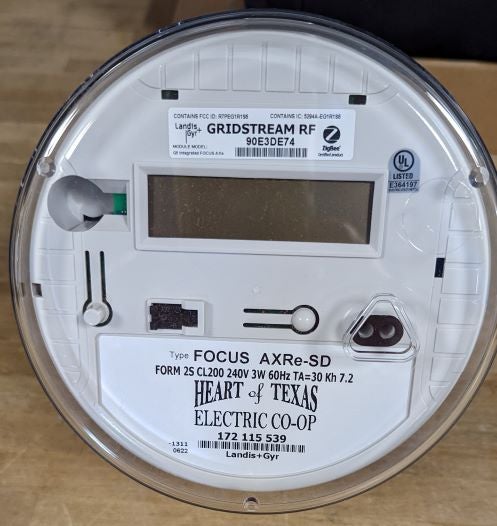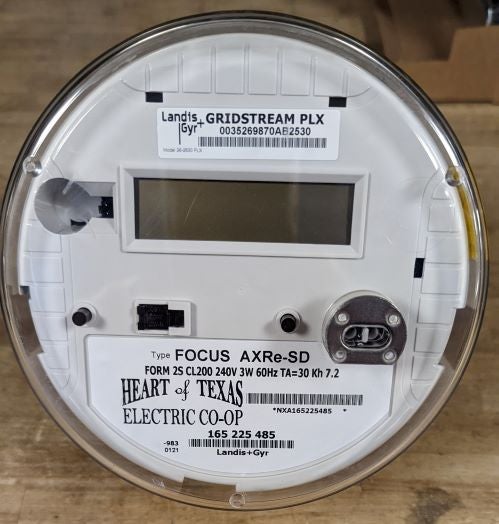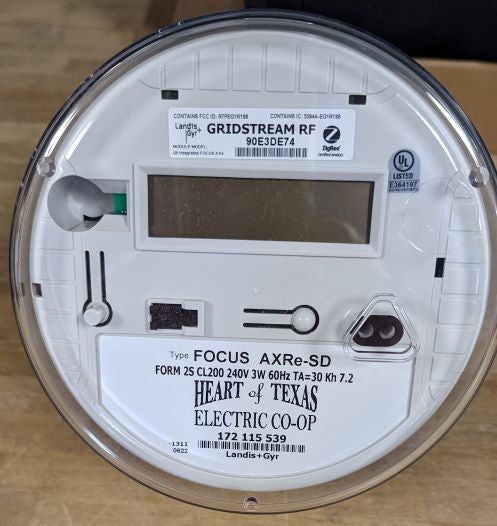Our PLX meters are our automated meter reading (AMR) system and they can help us do a number of different things. Read more about those things below.
The system provides peak demand usage data with a time stamp. We can use this information to build a load profile for use in properly sizing transformers.
The PLX metering system provides kWh usage, peak demand, and phase identification. All this can be used to help identify which loads to shift.
The signal strength analysis of the transmitters can provide location of failing equipment such as cracked insulators, bad switches, hot line clamps, and bad voltage regulators.
The PLX metering system monitors blinks and can identify the locations that experience blinks.
Using the PLX metering system, HOTEC is able to identify transmitters that have lost power.
At Heart of Texas Electric, we are committed to maintaining systems through system maintenance and diagnostic evaluation. Doing so regularly, we can reduce line loss.
The data that is collected can provide accurate, daily usage for each customer. This information can be used to resolve billing questions members may have.
New Meter Installations
At Heart of Texas Electric Cooperative, we have begun the process of swapping out PLX Meters in some homes and businesses and replacing them with Radio Frequency (RF) Meters. An RF smart meter with RF technology uses a low-power radio to communicate the electricity usage of a home or business to the electric company through remote telecommunication technologies.
HOTEC is strategically deploying the new RF Mesh system technology. We plan to deploy the system in phases until full implementation is complete. We estimate this will take 4 years.
Technology is always on the move
Brandon Young
General Manager
Everyone has their thoughts about the advancement of technology, but I must say that mostly I’m a fan. The modern conveniences we enjoy because of technology are plentiful and often taken for granted. When you think about heating and cooling your home at the touch of a thermostat, it likely doesn’t even register that it wasn’t that long ago we could not control those comforts. When we look at a cellphone—on which you may be reading this article— did you ever dream of having a handheld device that allows you to do so many amazing things? And just 10 years ago, our cars did not have nearly as many comfort and safety amenities as new models now offer.
Although I’m generally a fan of technological advancements, at times I suffer from technological advancement fatigue. The constant need for manufacturers to push out updates just when I’ve gotten comfortable with the device and features is often frustrating. Is this designed obsolescence for economic purposes, or purely driven by increased technological ability? I’m not sure, but like many things in life, it’s probably a little of both.
Mechanical Meters
At Heart of Texas Electric Cooperative, one area we’ve seen tremendous technological advancement is in electric meters. Many of you may recall around 30 years ago, our members read their meters and mailed the monthly meter reading to us with their bill payment. Then, once a year, a co-op employee would visit each meter to perform a safety inspection and read the meter. If reading true-ups were necessary, they would be handled on the next bill.
First Automated Reading Meters
During the late 1990s, power line carrier communications were invented. This allowed a digital device to be connected to the mechanical meter, which could measure disc revolutions and transmit meter readings through the powerline to a collector in our substation. The collector was connected to a modem that uploaded the data to our system and was used to populate meter readings in our billing system. This technology also sent additional data, allowing us to monitor and build a more efficient and resilient distribution system. This included peak load data that could be used for proper transformer sizing and blink counts, allowing us to identify failing equipment and vegetation control issues. However, this system was slow, and the data packets were only received daily due to its inability to rapidly deliver large amounts of data.
New Solid-State Meters
Approximately eight years ago, we began to deploy a new generation of PLC solid-state meters which offered significant advancements. Additionally, we were informed the early PLC technology would no longer be supported or sold by the manufacturer so upgrading was pretty much mandatory. As we know, this is not uncommon in our rapidly advancing technological world. Most of us replace iPads, laptops and cellphones every three to four years. Based on what we are experiencing in the advanced metering market, the life span of this technology ranges from 10 to 15 years.
The new technology did offer many advancements that we have used to increase engineering efficiencies and it interfaces with our outage management system. With this metering system, we received voltage at each location, 15-minute load-interval data for our engineering models to ensure we had proper available capacity throughout the system and two-way communications for relay.
The Latest in Metering Technology
We were recently notified that the PLX PLC meter technology will be deemed end of life, with final orders submitted in 2023 and software support terminated shortly thereafter. In response, Heart of Texas EC is strategically deploying the new RF Mesh system technology. We plan to deploy the RF Mesh system in phases until full implementation is complete. We estimate this will take 4 years.
The new technology offers 16-channels for transmitting metering and engineering data in near real-time, which will provide additional distribution efficiencies. The system also interfaces with our outage management and meter data management systems.
I have to admit, however, that the technology fatigue is setting in. Although the system’s speed and robust data options are useful, the added incremental value is not as great as the previous upgrades.
I believe that planned product obsolescence due to technological advances is just a part of our world I have to learn to accept, no matter how fatiguing. The only real option we have is to move to the next generation. Reverting to the simplicity of the old mechanical meter—while tempting—is just not practical.
Over the past 27 years, I’ve experienced significant changes in the electric utility industry— some of it for good, but some of it not so much—but change is inevitable.
What Meters Do
Regardless of the technology, meters do one thing—they measure watts and do it exactly the same way whether the meter is mechanical or digital. A watt is a watt. Your residential account meter measures your use of kilowatt-hours, a measurement of energy consumed over time. For example, if you have a 1,000-watt lightbulb and turn it on for one hour, you have consumed one kilowatt-hour. This is similar to a water meter or gas pump that measures gallons. Just as with the gas pump, you don’t see the fuel or electrons funneling through the meter. However, you observe the performance of those electrons as they power your lighting, HVAC system, refrigeration, water heater and most everything else in your home.
Contrary to some social media reports, the meters on the Heart of Texas EC system—and at utilities nationwide—are extremely accurate in tracking usage. If you ever have concerns about the accuracy of your meter or your home’s electric consumption, please reach out to us. We’ll be happy to check the meter and offer suggestions to increase your home’s energy efficiency.
Rest assured, while challenging at times, your cooperative is using technological advancements to run the most cost-effective and efficient distribution utility possible to provide our members with reliable service.




